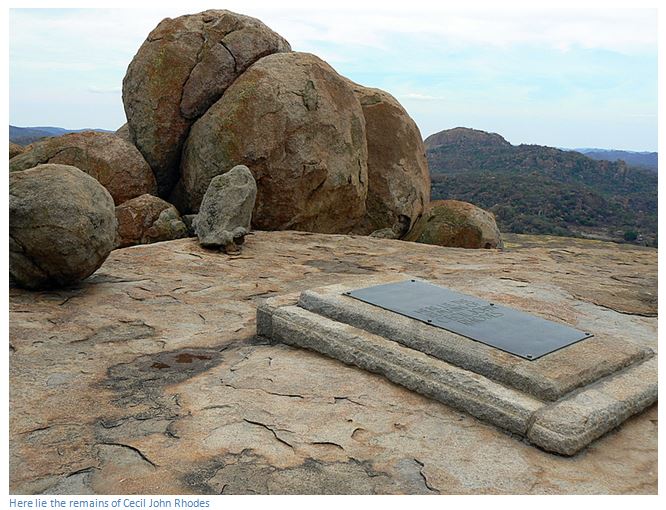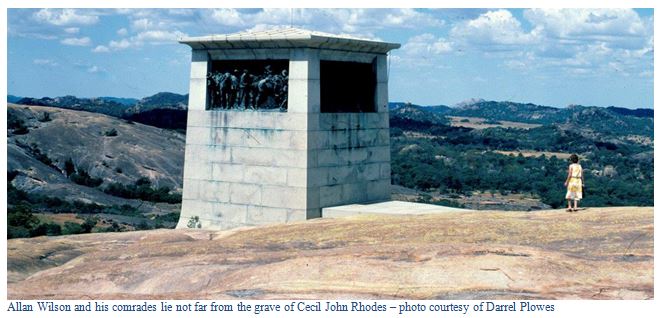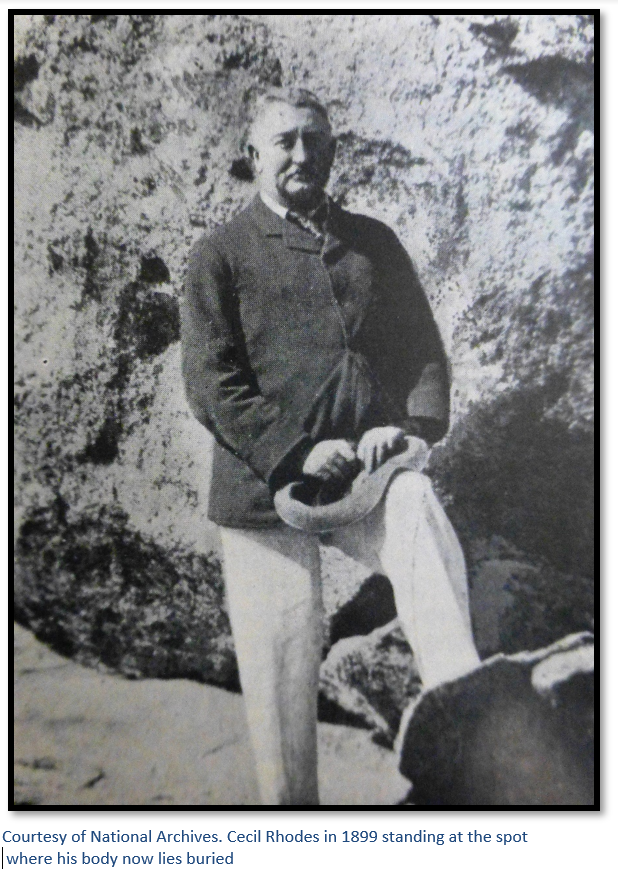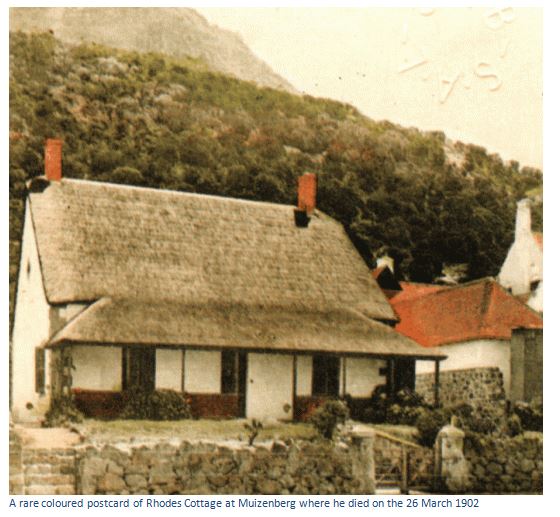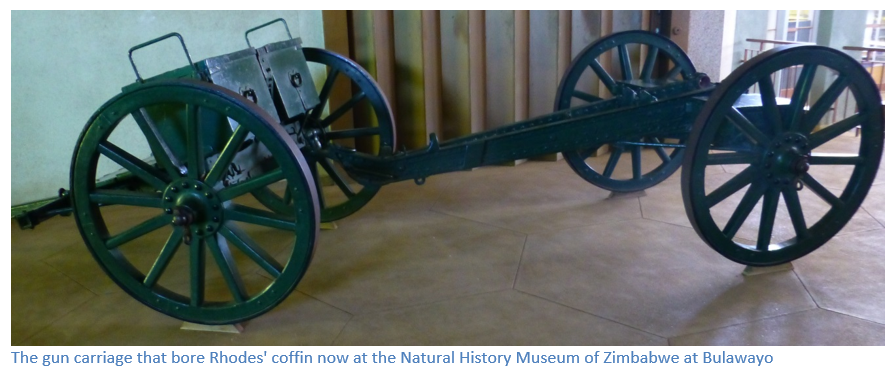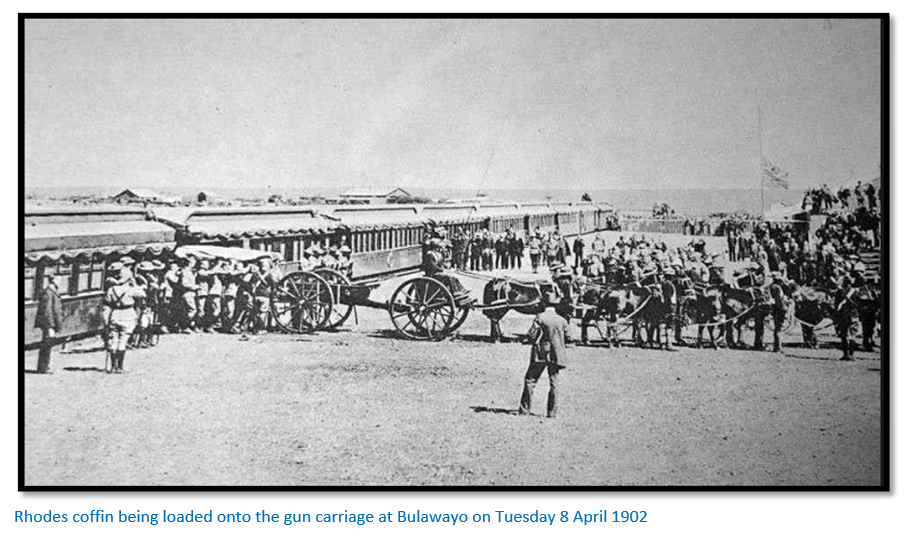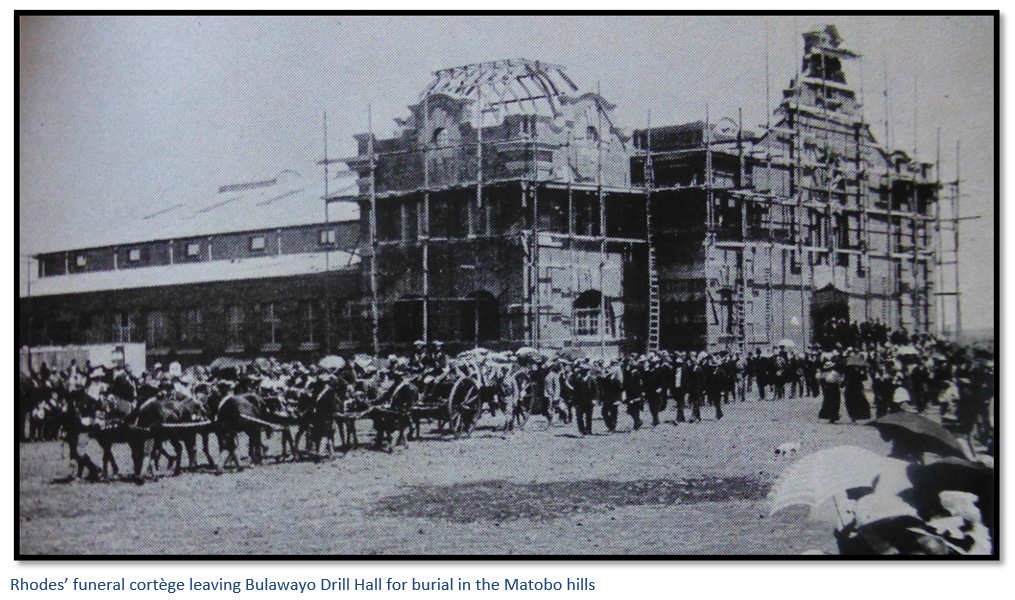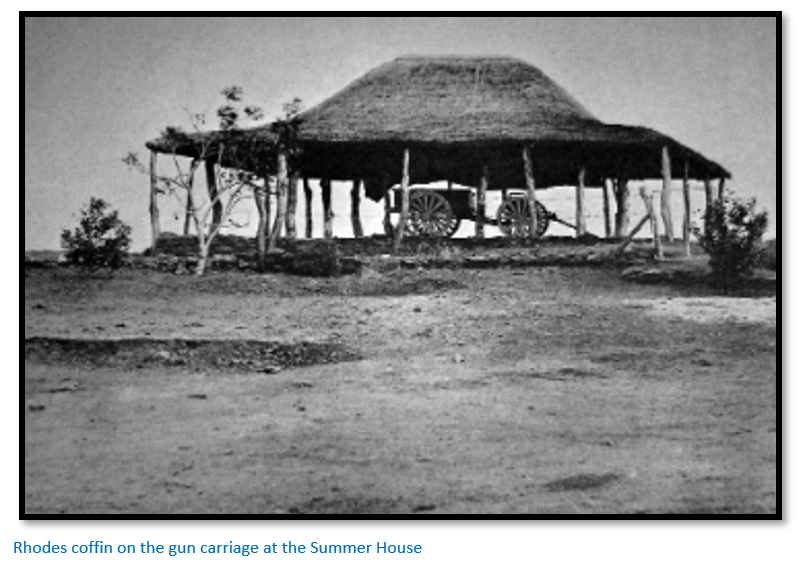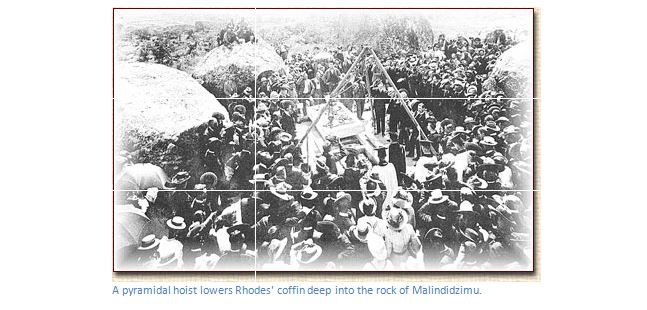World's View, Matobo
Cecil John Rhodes is buried at the site he described as having a “view of the World.”
World’s view is also the spiritual home for the Ndebele people and so named Malindidzimu.
Well sign-posted within the Matobo National Park.
GPS reference to car park: 20⁰29′29.26″S 28⁰30′44.20″E
Cecil Rhodes, Dr. Leander Starr Jameson and several other leading early white settlers, including Allan Wilson and all the members of the Shangani Patrol killed in the First Matabele War, are buried here on the summit of Malindidzimu, the “hill of benevolent spirits.” A short walk from the car park takes the visitor to the grave site on the solid granite hill which is surrounded by a natural amphitheatre of massive boulders.
Shortly after the third and final Indaba in September 1896 Rhodes and Dr. Hans Sauer went horse riding into the Matobo hills and in Sauer’s words: “we continued on our way by the curling and twisting narrow valleys between the immense boulders scattered about on their summits and sides. Rhodes’ attention was suddenly attracted to a formidable granite dome with some large boulders placed in circular form on the top. He proposed that we should dismount and climb to the top to get a good view. We tied our horses to a tree and after a long, but gradual ascent reached the summit. On arrival there we were rewarded with a magnificent view over the rugged masses of the Matopos. Rhodes was profoundly moved by the impressive panorama before us and said: This is the World’s View.” A few days later they went again and Rhodes spent an hour on the summit absorbed in his own thoughts. Sauer says: I have no doubt whatever that it was on this occasion that he made up his mind to be buried on the granite dome that he had named “The World’s View.”
Sir James McDonald, like Sauer a close friend of Rhodes and general manager of Gold Fields Rhodesian Development Company tells a somewhat different story in his book Rhodes: A life. Earl Grey was administrator of the country from April 1896 to December 1898 and in August 1896 had visited Rhodes on his farm to discuss various matters. Rhodes and Grey went riding in the Matobo Hills before breakfast and about 10am when they returned, Rhodes was in great spirits saying: “Grey and I have made a wonderful discovery; we’ve found a hill from the top of which a marvellous view is to be seen and the ascent is so easy that an old lady of eighty could easily walk up without assistance. You must all ride there this evening and we’ll show it to you.”
About 3pm they all set off and after about an hour’s riding they came to the foot of the hill and after throwing their horses’ reins over their necks were led up by Rhodes to the top of the hill where there was a fine view. Rhodes walked back and forth before saying: “I shall be buried here, looking in that direction (pointing north) and the remains of Allan Wilson and his party must be brought up here also and put inside the memorial I shall put up to their memory.”
McDonald wrote: “We sat for some time afterwards in the shade of the vast round boulders that seemed to have been thrown up from the bowels of the earth and Rhodes was very silent for a time.” Then he said to himself really: “The peacefulness of it all, the chaotic grandeur of it, it creates a feeling of awe and brings home to one how very small we all are.” Then back he came to the present: “Grey, I call this one of the world’s views.” We all agreed to that, hence its name today: “The World’s View.”
McDonald says they did not visit the site again for two years and all traces of the path became overgrown with bush. They knew the general direction, but there were hundreds of similar hills and two days of searching revealed no result. On the third day Rhodes was so irritable that McDonald avoided talking to him. Five of them were searching on horseback and every morning and afternoon they spent three hours on each occasion searching for the hill.
On the fourth day McDonald says he set out alone to follow up a thought that had occurred to him. They had crossed over a small sandy stream bed running out of a narrow opening in the hills. Two years previous there had been no river and he remembered a farmer saying that in December 1896 there had been a terrific storm when 23 centimetres of rain fell in four hours. He followed the stream bed and came into a long valley which he recognised from two years previously and soon arrived at the hill and walked to the top.
He arrived back about 11am to find Rhodes and the others at breakfast – they were a gloomy party. Rhodes somewhat sourly said: “Of course you’ve not found it?” In the most cheerful fashion I said: “I have.” He was on his feet in a second: “Are you sure? My horse, Tony – get my horse, Tony. You must take me back there right away McDonald. You’re sure you have got it? Let us be off” and off we went. There was no breakfast for me that day, just a coffee hastily swallowed. The rest of the party were told they would be taken later.
Rhodes pushed McDonald to ride hard and seemed very dubious until we reached the valley which he also remembered. After that he knew they were on the right track and calmed down. Then: “I had to find my hill McDonald, I had to find it; it has stayed with me since I saw it last, I fear I.ve been very irritable the past few days, but I had to find it and I shan’t forget how you stuck to it.”
We were soon on the top of the hill and Rhodes sat down under the shade of one of the rocks, saying to me soon after: “I shall stay here for a time, I am happy here, I want to think for a bit. You go back and have a meal and get a fresh horse and bring Metcalf and the other along. We must chaff them as to their insufficient exploring.” According to James McDonald that was how “The World’s View” was re-discovered.
I am unable to say which version; Sauer’s or McDonald’s is correct. Both were in the Matopos with Rhodes at the time of First Umvukela / Rhodes Indaba. Sir James McDonald’s book Rhodes: A Life was published in 1927; he was drowned when the S.S. Ceramic was torpedoed by U-515 in mid-Atlantic on 7 December 1942. There was only one survivor of the 655 passengers and crew who was taken prisoner aboard the submarine. There is a memorial to him in the Matobo National Park. Dr Hans Sauer published his book Ex Africa in 1937 and died in 1939.
The funeral of Cecil John Rhodes at Matopos, Zimbabwe
Although Rhodes remained a leading figure in the politics of southern Africa, he was dogged by ill health throughout his relatively short life. He was sent to Natal aged 16 because it was believed the climate might help the problems with his heart. On returning to England in 1872 his health again deteriorated with heart and lung problems, to the extent that his doctor, Sir Morell Mackenzie, believed he would only survive six months. He returned to Kimberley where his health improved. From age 40 his heart condition returned with increasing severity until his death from heart failure on 22nd March 1902, aged 49, at his seaside cottage in Muizenberg.
Rhodes had bought the cottage in 1899 from the widow of the late James Robertson Reid. It had been originally built as a thatched roof cottage, but had been changed to corrugated iron prior to Rhodes’ purchase, but in 1904 after his death the roof was replaced with thatch. In April 1921, the cottage was partially destroyed by a huge mountain fire and, but for the presence of the fire brigade who were on their way to another call, it would have been razed to the ground. De Beers Consolidated Mines revamped and redecorated the cottage in 1988 to mark the centenary of the company and today it is a Museum staffed by the Muizenberg Historical Society.
The cottage was left in the care of his personaql servant Tony Delacrax until 1904. Thereafter, the roof was altered and the cottage was boarded up until 1932 after which it was handed over to the Northern Rhodesian Government (now Zambia) as a rest and recreational home for their civil servants. In 1937, it was handed over to the Cape Town City Council and in 1953 was converted into a museum.
After his death, Rhodes' body was taken by night to Groote Schuur where it lay in state. Arrangements were hastily made to carry out his wishes as expressed in his last Will and Testament: “I admire the grandeur and loneliness of the Matopos in Rhodesia and therefore I desire to be buried in the Matopos on the hill which I used to visit and which I called a 'View of the World", in a square to be cut in the rock on the top of the hill, covered with a plain brass plate with the words thereon: "Here lie the remains of Cecil John Rhodes.”
Rhodes' coffin was massive, consisting of three separate coffins - an outer shell of Matabele teak which enclosed two inner coffins, each made of metal. Attached to the sides of the outer coffin were eight huge handles of beaten brass bearing Rhodes' monogram. These were cast, beaten, finished and delivered within four days of the order being given, a team of artisans having worked night and day to do the job.
After the funeral service, Rhodes' coffin was put on a special train at Cape Town station - its funeral carriage draped with black velvet and purple silk and the train travelled northwards for five days across the entire length of South Africa and then to Bulawayo. At every significant station along the way, thousands of mourners lined the flower-laden platforms.
The gun-carriage itself is described by Roger Summers in an article Some Stories behind historical relics in the National Museum, Bulawayo in Rhodesiana Publication No 26 of July 1972. It is the carriage of a mountain gun, probably a RML seven-pounder Rifled Muzzle Loader used by the Indian Army and elsewhere on this website at the battle of Chua Hills at Fort Massi-Kessi [see the article on How Manicaland was annexed from the Portuguese under Manicaland on the website www.zimfieldguide.co]
Unfortunately after many years of neglect the gun-carriage fell to bits from dry-rot and had to be restored by Mr Perks a wagon builder who was forced to substitute wagon wheels which are a bit smaller than the original wheels. The restoration was paid for by Stanley and John Sly of Haddon and Sly and was then presented to Bulawayo Municipality. It stood outside the Town Hall before being moved to Government House and finally to the Natural History Museum of Zimbabwe at Bulawayo.
For the procession from Bulawayo station to the Drill Hall the gun-carriage was hauled by a team of eight mules each led by a groom.
On 9th April 1902 after lying in state at Bulawayo, followed by another funeral service, the funeral cortege left Bulawayo Drill Hall with the coffin resting on a gun-carriage pulled by mules to Rhodes’ farm where the gun carriage spent the night under his Summer House on the Westacre Estate as seen in the photo below. From there it was drawn by oxen who took the gun carriage up to the summit of Malindidzimu without the assistance of the Police on drag-ropes.
The special funeral road of more than 25 kilometres having been carved through the rocky terrain during the preceding days by a team of about a thousand AmaNdebele. These historic photos are from Cecil John Rhodes: A Chronicle of the funeral ceremonies from Muizenberg to the Matoppos March – April 1902
There were no motor cars then, but every imaginable conveyance of those times was brought into use for the occasion – Zeederberg’s coaches which used to convey mails and passengers throughout Rhodesia (now Zimbabwe) and to and from the South, buckboards, Cape carts, all drawn by spans of mules, utility carts, ox-wagons and bicycles and a big contingent on horseback.
Until three weeks previously the road was merely a rough cattle track, and despite the work put into it was difficult to negotiate at times, particularly on entering the hills where gangs of work men were placed at various points to make very necessary repairs after the passage of heavy vehicles.
At the main outspan the mules drawing the gun carriage were replaced by twelve black oxen, which had been specially trained during the preceding fortnight to mount the steep approaches with a heavy load; and to the relief of those in charge the oxen at these points took the strain, as was said at the time “as quietly as if they were ploughing a furrow” and gun carriage arrived safely at the summit. Troopers of the British South African Police had been stationed at the difficult sections of the route holding guide ropes attached to the gun carriage in case the oxen failed to negotiate the slippery slopes.
On the 10th April 1902 Rhodes' coffin was finally embedded at the summit of 'World's View', a huge dome of granite which the local Kalanga people refer to as Malindidzimu ('the haunt of the ancestral spirits').
The Ndebele Chiefs requested that guns were not fired at the funeral as tradition dictates because it would disturb the spirits in the vicinity; they sent him on his way with the Ndebele royal salute "Bayete". It was at the burial ceremony that Bishop Gaul of Mashonaland read the verse by Rudyard Kipling which subsequently became so well known:
“That immense and brooding spirit still
Shall quicken and control
Living he was the land, and dead
His soul shall be her soul.”
Two of the most impressive incidents in the proceedings apart from the religious Service and the oration by the Bishop of Mashonaland, were the Royal Salute, or “Bayete”, given in a mighty roar by thousands of Ndebele tribesman to express their sorrow at the passing of a great Chief.
In March 1904 the remains of the small party of Victoria Rangers and Salisbury Horse led by Allan Wilson were buried some one hundred and fifty yards away in an imposing granite monument with four bronze panels by the sculptor John Tweed. The main inscription reads: “Erected to the enduring memory of Allan Wilson and his men who fell in fight against the Matabele on the Shangani River, December 4th 1893. There was no survivor.” The battle took place on 3rd December 1893 far to the north on the Shangani River and their remains were recovered by the trader Dawson (his inscription on the tree: “To Brave Men” can be seen in the museum of Natural History in Bulawayo) and their remains were buried at Great Zimbabwe, until re-buried in the Matobo at World’s View.
Also buried here on 10th May 1920 is Leander Starr Jameson, Rhodes’ lifelong friend who succeeded Colquhoun as Administrator of Mashonaland and on 14th August 1930 the first Premier of the Colony, Charles Patrick John Coghlan.
Acknowledgements
C. Shee. The burial of Cecil Rhodes. Rhodesiana Magazine. No. 18 of July 1968. P37-46
F.E. Masey. Cecil John Rhodes: A Chronicle of the funeral ceremonies from Muizenberg to the Matoppos March – April 1902. Books of Rhodesia, Bulawayo 1972
R. Summers. Some Stories behind historical relics in the National Museum, Bulawayo in Rhodesiana Publication No 26 of July 1972
Wikipedia

